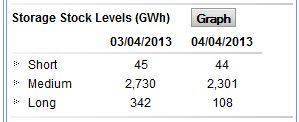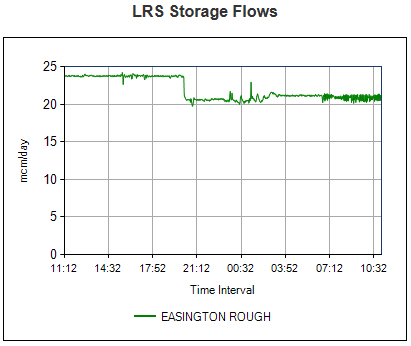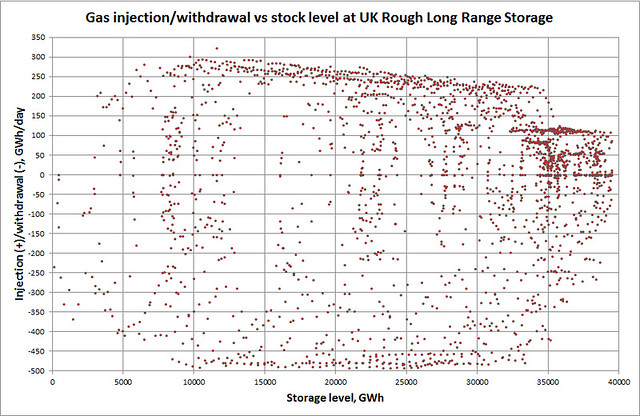Yesterday (4 April 2013) afternoon, the UK long-range gas storage facility at Rough went 'below empty' for the first time. This is possible because Centrica normally leaves some 'cushion gas' in the depleted Rough reservoir to make sure there’s enough pressure to keep it flowing properly. Here's the status, taken from the Prevailing View page, showing figures valid for 6am on the 3 and 4 April 2013:
The 4pm udpate today gives the Long Range stock level as -132 GWh, a negative stock level! I got this from the spreadhseet on this page, as the Prevailing View is being a bit slow to update today - maybe it's struggling over what to do with a negative stock level?
It was clear this was going to happen, because the Entry Zone graphs have been showing gas flowing out of Rough at over 20 mcm/day (image shows 24 hours from 4-5 April 2013):
20mcm is about 220 GWh, so with only 108 GWh in Rough yesterday at 6am, it was clear we were going to dip below zero. The fact that we are now burning through this normally untouched 'cushion gas' reserve is a sign of the problems we have right now, and does not bode well for next winter, as everything that is pumped now ought to be put back in before the end of October to guarantee winter supplies.
According to National Grid, gas can be injected into Rough at a rate of 220 GWh/day, and the maximum capacity is 39,405 GWh. In practice, the injection rate varies according to the stock level, because the more gas is stored, the higher the pressure, so the harder it is to force more gas in. I've plotted injection/withdrawal rates vs. stock level from 2007 to date on the graph below (click for a larger version on Flickr):
As you can see, the injection rate can get up to around 300 GWh/day when the store is nearly empty, but drops steadily towards 220 GWh/day as it fills, and drops quickly to 100 GWh/day when it is nearly full. Withdrawals are relatively unaffected by stock level - they are lower at the top end simply because demand is lower, and there are tentative signs of them dropping off a bit at the bottom end, presumably because of the falling pressure.
Anyway, if we assume 220 GWh/day is an average value, this implies 179 days, or about six months, to refill from empty. This year, we will be starting from below what is normally considered 'empty', so it seems unlikely that we will be able to refill the long-range stores by the end of October. Another barrier to refilling storage is planned outages, with the UK's Teeside gas terminal undergoing maintenance from tomorrow and possible reductions in Norwegian gas supplies to the UK from Monday, according to Reuters.
Combine the above with the shutdown of several GW of coal-fired power stations in 2013 and the continuing decline in North Sea gas output, and it is clear that wholesale gas prices are going to stay very high throughout 2013. This will inevitably feed through into higher gas and electricity prices for domestic and business customers, as the alternative is to let the lights go out.
The only action that can be taken in the time available is to launch a crash-programme of energy saving between now and Autumn, insulating homes, improving heating system efficiency and persuading people to wear warmer clothes and turn the thermostat down. Doing this brings a direct benefit, as your heating bills will come down, and if enough of the UK population does it, the reduced demand could help reduce wholesale prices too, as we will be able to import less gas.
Will this action be taken by more than a handful of people? Sadly, I doubt it, as nobody in a position of power is pushing for it.
Mike



Thanks for this update Mike. Energy policy is something you can't play with.
ReplyDeleteIf only the govt here had figured this out some years ago...
Delete